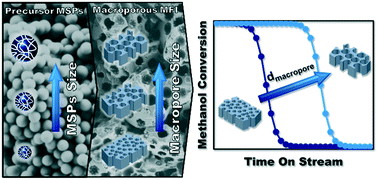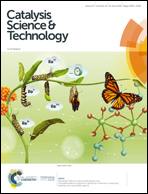Hierarchical MFI type zeolites with intracrystalline macropores: the effect of the macropore size on the deactivation behaviour in the MTO reaction†
Abstract
Hierarchically structured ZSM-5 catalysts have been prepared using different sized mesoporous silica particles as the sacrificial template, resulting in zeolite crystals with different sized intracrystalline macropores but very similar zeolitic characteristics such as crystallinity, chemical composition, and acidic and textural properties. This set of catalysts was used to investigate the effect of intracrystalline macropores on the deactivation behaviour of ZSM-5 catalysts in the conversion of methanol to olefins (MTO). The catalytic tests showed that the incorporation of macropores was very beneficial in improving the catalyst lifetime in the MTO reaction. This improved performance was correlated to the reduced coke formation during the reaction, likely a result of the enhanced transport of reactants and products in the zeolite crystals due to the well-interconnected macropores. Also worth mentioning is the effect of the dimensions of the additional macropores on the rate of coke formation. Increasing the macropore size by a factor of two led to a decrease in coke formation and consequently a two times longer catalyst lifetime.



 Please wait while we load your content...
Please wait while we load your content...